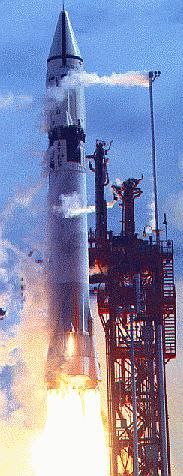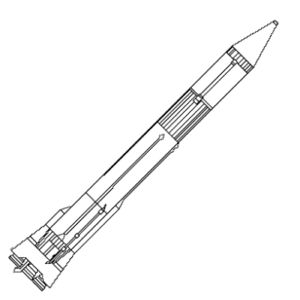
Home - Search - Browse - Alphabetic Index: 0- 1- 2- 3- 4- 5- 6- 7- 8- 9
A- B- C- D- E- F- G- H- I- J- K- L- M- N- O- P- Q- R- S- T- U- V- W- X- Y- Z
Atlas Centaur LV-3C
FURTHER INFORMATION ON THIS TOPIC AT OUR PARTNER SITE
 Atlas LV Atlas LV-3C s/n AC-3 / Centaur D s/n 135D - 1964-06-30 |
AKA: LV-3C. Payload: 1,700 kg (3,700 lb). Thrust: 173,843.00 kN (39,081,461 lbf). Gross mass: 136,124 kg (300,102 lb). Height: 33.00 m (108.00 ft). Diameter: 3.05 m (10.00 ft).
Payload: 1,700 kg (3,700 lb) to a GTO.
Stage Data - Atlas Centaur LV-3C
- Stage 0. 1 x Atlas MA-3. Gross Mass: 3,174 kg (6,997 lb). Empty Mass: 3,174 kg (6,997 lb). Thrust (vac): 1,644.960 kN (369,802 lbf). Isp: 290 sec. Burn time: 120 sec. Isp(sl): 256 sec. Diameter: 4.90 m (16.00 ft). Span: 4.90 m (16.00 ft).Propellants: Lox/Kerosene. No Engines: 2. Engine: LR-89-5. Status: In Production.
- Stage 1. 1 x Atlas Centaur LV-3C. Gross Mass: 117,350 kg (258,710 lb). Empty Mass: 3,700 kg (8,100 lb). Thrust (vac): 363.218 kN (81,655 lbf). Isp: 309 sec. Burn time: 335 sec. Isp(sl): 215 sec. Diameter: 3.05 m (10.00 ft). Span: 4.90 m (16.00 ft). Length: 18.30 m (60.00 ft). Propellants: Lox/Kerosene. No Engines: 1. Engine: XLR-105-5. Status: Out of Production.
- Stage 2. 1 x Centaur C. Gross Mass: 15,600 kg (34,300 lb). Empty Mass: 1,996 kg (4,400 lb). Thrust (vac): 133.448 kN (30,000 lbf). Isp: 425 sec. Burn time: 430 sec. Diameter: 3.05 m (10.00 ft). Span: 3.05 m (10.00 ft). Length: 9.14 m (29.98 ft). Propellants: Lox/LH2. No Engines: 2. Engine: RL-10A-1. Status: Out of Production.
More at: Atlas Centaur LV-3C.
Family: orbital launch vehicle. Country: USA. Engines: LR105-5, LR89-5, XLR105-5, LR89-7, RL-10A-3, RL-10A-1. Spacecraft: Mariner 1-2. Launch Sites: Wallops Island. Stages: Centaur C, Atlas Centaur LV-3C stage, Atlas MA-3. Agency: Convair.
 | Atlas LV Atlas LV-3C s/n AC-3 - 1964-06-30 |
 | Atlas Centaur C Credit: © Mark Wade |
1958 October 1 - . LV Family: Atlas. Launch Vehicle: Atlas Centaur LV-3C.
- Centaur engine contract awarded. - . Nation: USA. Air Force awarded contract Pratt & Whitney for Centaur vehicle with hydrogen-burning chamber based on research of Lewis Research Center between 1953 and 1957. Centaur project later transferred to NASA..
1959 January 15 - . LV Family: Atlas. Launch Vehicle: Atlas Centaur LV-3C.
- Centaur first contract. - . Nation: USA. Centaur project (Atlas upper stage) contracted for $7 million in its first year.
1960 November 1 - . LV Family: Atlas. Launch Vehicle: Atlas Centaur LV-3C.
- Centaur tracking network test. - .
Nation: USA.
Under arrangements of the AACB (Aeronautics and Astronautics Coordinating Board), NASA will utilize existing NASA tracking stations for initial Centaur development vehicles and switch to the Advent network (which is to be planned, funded, and constructed by DOD) when Centaur is operational, perhaps as early as the fourth of 10 development launchings of Centaur.
1961 February 7 - . LV Family: Atlas. Launch Vehicle: Atlas Centaur LV-3C.
- Centaur development milestones set. - . Nation: USA. Meeting of NASA and contractor personnel held at NASA headquarters to review Centaur development program..
1961 July 7 - . LV Family: Atlas. Launch Vehicle: Atlas Centaur LV-3C.
- McDonnell studies of the redesigned Mercury spacecraft. - .
Nation: USA.
Spacecraft: Gemini,
Gemini Ejection,
Gemini Parachute.
Walter F. Burke of McDonnell summarized the company's studies of the redesigned Mercury spacecraft for Space Task Group's senior staff. McDonnell had considered three configurations: (1) the minimum-change capsule, modified only to improve accessibility and handling, with an adapter added to carry such items as extra batteries; (2) a reconfigured capsule with an ejection seat installed and most of the equipment exterior to the pressure vessel on highly accessible pallets; and (3) a two-man capsule, similar to the reconfigured capsule except for the modification required for two rather than one-man operation. The capsule would be brought down on two Mercury-type main parachutes, the ejection seat serving as a redundant system. In evaluating the trajectory of the two-man capsule, McDonnell used Atlas Centaur booster performance data.
1961 August 1 - . LV Family: Atlas. Launch Vehicle: Atlas Centaur LV-3C.
- Centaur operational contracts initiated. - . Nation: USA. NASA directed Marshall Space Flight Center to enter contract negotiations with contractors for procurement of five operational Atlas-Centaur vehicles. These launchings were planned to begin in second quarter of 1964..
1961 September 28 - . LV Family: Atlas. Launch Vehicle: Atlas Centaur LV-3C.
- Mariner moved to Atlas-Agena due to Centaur delay. - . Nation: USA. Program: Mariner. Class: Venus. Type: Venus probe. Spacecraft Bus: Mariner. Spacecraft: Mariner 1-2. NASA announced that instrumented Venus probe to be launched next year would be launched by an Atlas-Agena B rather than a Centaur rocket as originally planned..
1961 November 19 - . LV Family: Atlas. Launch Vehicle: Atlas Centaur LV-3C.
- RL-10 flight rating complete. - .
Nation: USA.
NASA announced the completion of the preliminary flight rating test of the Nation's first liquid-hydrogen rocket engine. The engine, the RL-10, was designed and developed by Pratt and Whitney, of United Aircraft, for the Marshall Space Flight Center, and 20 captive firings were competed within 5 days under simulated space conditions, consistently producing 15,000 pounds of thrust. RL-10, previously known as XLR-115, was initiated in October 1958 and over 700 firings were conducted in its development.
Back to top of page
Home - Search - Browse - Alphabetic Index: 0- 1- 2- 3- 4- 5- 6- 7- 8- 9
A- B- C- D- E- F- G- H- I- J- K- L- M- N- O- P- Q- R- S- T- U- V- W- X- Y- Z
© 1997-2019 Mark Wade - Contact
© / Conditions for Use